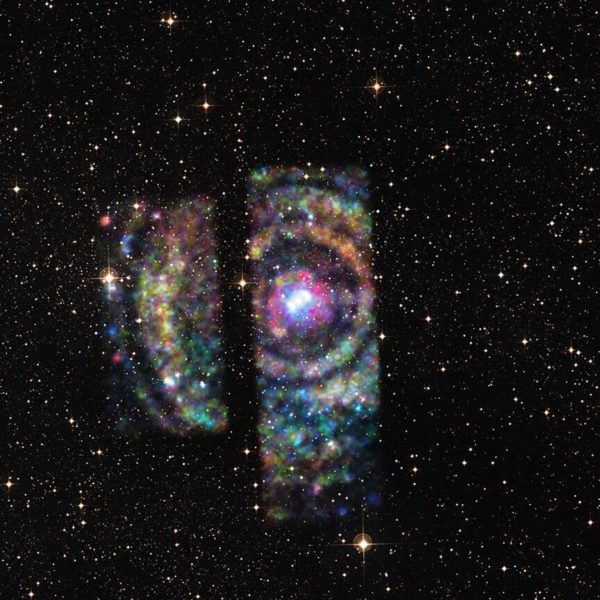The largest and brightest set of cosmic rings resulting from echoes of X-ray light has been discovered by a science team that includes a Penn State astronomer. The team used NASA’s Chandra X-ray Observatory to discover the beautiful and extraordinary rings, which were produced by an intense burst of energy from a neutron star. Rings of this type give astronomers a rare chance to determine the distance from Earth to an object in our Milky Way Galaxy.
“It’s really hard to get accurate distance measurements in astronomy and we only have a handful of methods,” said Sebastian Heinz of the University of Wisconsin who led the study, which will be published in the Astrophysical Journal. “But just as bats use sonar to triangulate their location, we can use the X-rays from Circinus X-1 to figure out exactly where it is.” The X-ray camera used for this research on the Chandra X-ray Observatory was conceived and developed for NASA under the leadership of Gordon Garmire, Evan Pugh Professor Emeritus of Astronomy and Astrophysics at Penn State.
The X-ray ring system gave the astronomers a rare opportunity to pin down the previously uncertain distance to Circinus X-1, an object whose behavior and powerful jets of high-energy particles also have puzzled scientists. The rings appear as circles around Circinus X-1 — a double-star system with one star that is considered to be “normal” because, like the Sun, it ultimately is powered by nuclear fusion, plus one super-dense neutron star, which consists almost entirely of neutrons. The two stars simultaneously orbit each other. The neutron star — the densely packed remains from a massive supernova explosion — is located in the plane of the Milky Way behind thick clouds of interstellar gas and dust.
“Circinus X-1 is a wondrous X-ray binary star system — truly a gift that keeps on giving,” said W. Niel Brandt, the Willaman Professor of Astronomy and Astrophysics at Penn State and a member of the discovery team who has been studying the Circinus X-1 star system for two decades. “Just over the past 15 years, studies of this system have provided us with novel insights into the million-mile-per-hour winds launched from the vicinity of the system’s neutron star, with the youngest example of an X-ray binary, with a new supernova remnant, and now with these superlative X-ray light echoes. I can’t wait to see the surprises from the next decade of Circinus X-1 studies.”
The detection and characterization of the rings required the unique capabilities of Chandra: the ability to detect fine details combined with sensitivity to faint signals. The research team determined that the rings are echoes of X-ray light produced when Circinus X-1 emitted a burst of X-rays in late 2013. The X-rays then reflected off intervening clouds of dust. Some of these reflected X-rays then headed toward Earth and arrived here from different angles with a time delay of about one to three months, creating the rings discovered by the research team.
An analysis of the rings, together with radio data on the distance to the clouds, allows researchers to use simple geometry to determine accurately the distance to Circinus X-1 from Earth. The Chandra observations reveal four concentric rings around the neutron star. By comparing the Chandra data to images of dust clouds detected by the Mopra radio telescope in Australia, the researchers determined that each ring was created when light from the 2013 outburst reflected off of a different dust cloud. The radio data provide the distance to the different clouds and the X-ray echo determines the location of Circinus X-1 relative to the clouds. “We like to call this system the ‘Lord of the Rings,’ but this one has nothing to do with Sauron,” said co-author Michael Burton of the University of New South Wales in Sydney, Australia. “The beautiful match between the Chandra X-ray rings and the Mopra radio images of the different clouds is really a first in astronomy.”
The light echo shows that Circinus X-1 is located about 30,700 light years from Earth. This observation settles a large difference among previous results — one similar to this work and one indicating a much smaller distance of about 13,000 light years, the scientists say. This increased distance estimate would mean that Circinus X-1 is inherently much more powerful in X-rays and other types of light than some scientists used to think. The new distance measurement indicates that Circinus X-1 has repeatedly passed a key threshold for brightness where the outward pressure from radiation by the system is balanced by the inward pull of gravity. This behavior is something astronomers generally see more often in systems containing black holes than in systems like Circinus X-1 that contain a neutron star.
The researchers also determined that the speed of the jet of high-energy particles produced by the system is at least 99.9 percent of the speed of light. This extreme velocity is usually associated with jets produced by a black hole. “Circinus X-1 acts in some ways like a neutron star and in some ways like a black hole,” said co-author Catherine Braiding, also of the University of New South Wales. “It’s extremely unusual to find an object that has such a blend of these properties.”
Circinus X-1 is thought to have originally become an X-ray source about 2,500 years ago, making Circinus X-1 the youngest X-ray binary known. This study also allowed the astronomers to make a detailed three-dimensional map of the dust clouds between Circinus X-1 and Earth, providing a valuable probe of the structure of the Milky Way Galaxy.
NASA’s Marshall Space Flight Center in Huntsville, Alabama, manages the Chandra program for the agency’s Science Mission Directorate in Washington. The Smithsonian Astrophysical Observatory in Cambridge, Massachusetts, controls Chandra’s science and flight operations.

